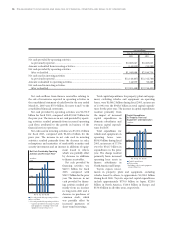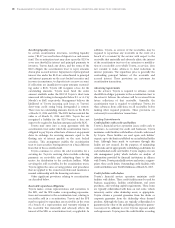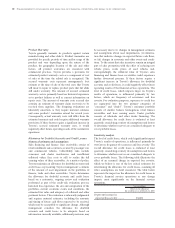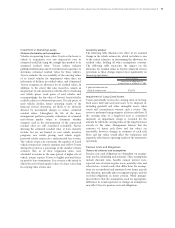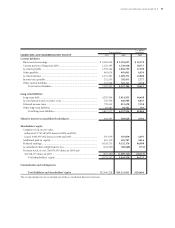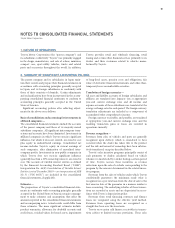Toyota 2005 Annual Report Download - page 74
Download and view the complete annual report
Please find page 74 of the 2005 Toyota annual report below. You can navigate through the pages in the report by either clicking on the pages listed below, or by using the keyword search tool below to find specific information within the annual report.
72 >MANAGEMENT’S DISCUSSION AND ANALYSIS OF FINANCIAL CONDITION AND RESULTS OF OPERATIONS
Product Warranty
Toyota generally warrants its products against certain
manufacturing and other defects. Product warranties are
provided for specific periods of time and/or usage of the
product and vary depending upon the nature of the
product, the geographic location of the sale and other
factors. All product warranties are consistent with
commercial practices. Toyota provides a provision for
estimated product warranty costs as a component of cost
of sales at the time the related sale is recognized. The
accrued warranty costs represent management’s best
estimate at the time of sale of the total costs that Toyota
will incur to repair or replace product parts that fail while
still under warranty. The amount of accrued estimated
warranty costs is primarily based on historical experience
as to product failures as well as current information on
repair costs. The amount of warranty costs accrued also
contains an estimate of warranty claim recoveries to be
received from suppliers. The foregoing evaluations are
inherently uncertain, as they require material estimates
and some products’ warranties extend for several years.
Consequently, actual warranty costs will differ from the
estimated amounts and could require additional warranty
provisions. If these factors require a significant increase in
Toyota’s accrued estimated warranty costs, it would
negatively affect future operating results of the automotive
operations.
Allowance for Doubtful Accounts and Credit Losses
Natures of estimates and assumptions
Sales financing and finance lease receivables consist of
retail installment sales contracts secured by passenger cars
and commercial vehicles. Collectibility risks include
consumer and dealer insolvencies and insufficient
collateral values (less costs to sell) to realize the full
carrying values of these receivables. As a matter of policy,
Toyota maintains an allowance for doubtful accounts and
credit losses representing Toyota management’s estimate
of the amount of asset impairment in the portfolios of
finance, trade and other receivables. Toyota determines
the allowance for doubtful accounts and credit losses
based on a systematic, ongoing review and evaluation
performed as part of the credit-risk evaluation process,
historical loss experience, the size and composition of the
portfolios, current economic events and conditions, the
estimated fair value and adequacy of collateral and other
pertinent factors. This evaluation is inherently judgmental
and requires material estimates, including the amounts
and timing of future cash flows expected to be received,
which may be susceptible to significant change. Although
management considers the allowance for doubtful
accounts and credit losses to be adequate based on
information currently available, additional provisions may
be necessary due to (i) changes in management estimates
and assumptions about asset impairments, (ii) informa-
tion that indicates changes in expected future cash flows,
or (iii) changes in economic and other events and condi-
tions. To the extent that sales incentives remain an integral
part of sales promotion with the effect of reducing new
vehicle prices, resale prices of used vehicles and,
correspondingly, the collateral value of Toyota’s sales
financing and finance lease receivables could experience
further downward pressure. If these factors require a
significant increase in Toyota’s allowance for doubtful
accounts and credit losses, it could negatively affect future
operating results of the financial services operations. The
level of credit losses, which impacts larger on Toyota’s
results of operations, is influenced primarily by two
factors, which are frequency of occurrence and loss
severity. For evaluation purposes, exposures to credit loss
are segmented into the two primary categories of
“consumer” and “dealer”. Toyota’s consumer portfolio
consists of smaller balance homogenous retail finance
receivables and lease earning assets. Dealer portfolio
consists of wholesale and other dealer financing. The
overall allowance for credit losses is evaluated at least
quarterly, considering a variety of assumptions and factors
to determine whether reserves are considered adequate to
cover probable losses.
Sensitivity analysis
The level of credit losses, which could significantly impact
Toyota’s results of operations, is influenced primarily by
two factors: frequency of occurrence and loss severity. The
overall allowance for credit losses is evaluated at least
quarterly, considering a variety of assumptions and factors
to determine whether reserves are considered adequate to
cover probable losses. The following table illustrates the
effect of an assumed change in expected loss severity,
which we believe is one of the key critical estimates for
determining the allowance for credit losses, assuming all
other assumptions are held consistent. The table below
represents the impact on the allowance for credit losses in
Toyota’s financial services operations as any change
impacts most significantly on the financial services
operations.
Yen in millions
Effect on the allowance
for credit losses as of March 31, 2005
10 percent increase in
expected loss severity........... ¥4,081




